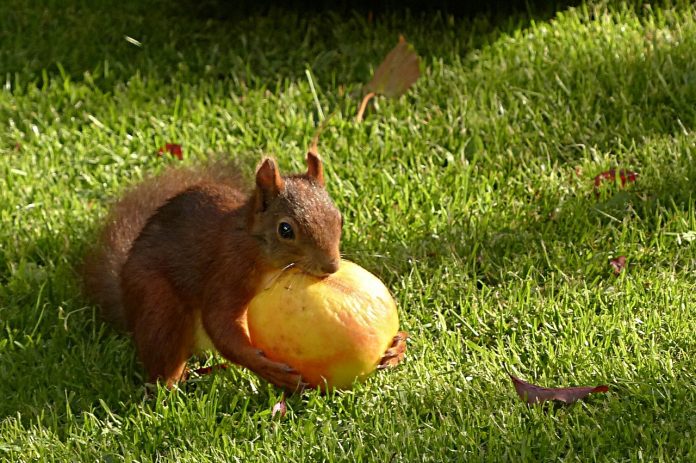Living in the woods provides endless entertainment. I get to share my space with a variety of quirky, unique and beautiful creatures.
The squirrels are actually one of my favorites. They are the tiny daredevils of the canopy, leaping fearlessly from one branch to the next, scaling up tree bark to escape predators and find a reprieve from the dangers below (usually my Chiweenies) and stashing away acorns and other goodies for later.
My daughter is endlessly amused with one squirrel in particular. We call it the crazy squirrel. This one is particularly brazen in its pursuits and has barely a nub for a tail left. Whether it’s darting in and out of our dogs’ house to help itself to the food dish or making a mad dash for the apple tree with both dogs hot on what’s left of its tail, this squirrel is always pulling off the most jaw-dropping heists and escapes.
And it’s not easily deterred. We’ve tried keeping it off the apple tree by placing pie pans around the trunk and branches. We’ve tried sending the dogs after it. We’ve even tried spraying a mixture of cayenne pepper and water on the tree to keep it off. But it likes apples.
There are a lot of strategies and considerations for keeping squirrels off of fruit trees. Learn more about the most popular ones.
Metal tree baffles
Metal tree baffles can be successful at keeping squirrels off of trees. This was the idea behind the pie pans; however, there are two reasons this wasn’t a successful strategy.
- Effective cone-shaped baffles must be 2 feet in diameter. Pie pans are much too small to be effective.
- Baffles must be placed on the trunk about 5 feet from the ground because squirrels can jump past them otherwise. The first branches of our apple tree start about 3-4 feet up the trunk.
Although baffles aren’t the answer in my situation, they could work for you. You can try using either cone baffles or metal tube baffles to protect your trees.
If you use cone baffles, make sure they are at least 2 feet in diameter and the cone is installed so that it slopes downward.
If you choose a tube baffle, you’ll need metal ducting that’s wider in diameter than the trunk of your tree and about 2-3 feet long. You’ll want to install it 5-6 feet off the ground — the same as the cone baffle — and make sure the top is closed off, so no squirrels can slip underneath it.
You might also consider rubbing petroleum jelly or another oil substance on the outside of the baffle to discourage squirrels further. They don’t like oily or sticky substances. However, it may not be a good idea to put such a substance directly on tree bark because it can harm the tree.
Netting
Netting is another strategy for keeping squirrels off of fruit trees. However, its effectiveness is limited.
If you have more than one apple tree, you can try protecting one tree with netting and sacrificing the other. Generally, squirrels will leave the protected tree alone and eat the easier-to-access apples. If you’re in the same boat I am and you only have one apple tree, netting probably won’t be very effective because squirrels are able to chew through bird netting.
In one-apple-tree situations, you could try taking it a step further and construct a sort of cage around your tree, using T-posts and hardware cloth to exclude squirrels. However, it would be a lot more work to enclose your tree entirely this way.
Hot peppers
The capsaicin in hot peppers can deter squirrels. The only downfall is having to reapply it every time it rains. I think that’s why I’ve had limited success spraying my apple tree with a hot pepper mixture.
You can try commercial products or make your own. To make your own hot pepper spray, mix a small bottle of hot sauce with a gallon of water. You can apply it to your fruit trees using a spray bottle.
Mint and other aromatic plants
A lot of animals are repelled by the scent of mint and squirrels are one of them. You could try planting some mint under your fruit trees or make a spray similar to the hot pepper spray using peppermint or spearmint essential oils and water. Again, you’ll have to reapply the spray periodically to ensure it’s effective.
Marigolds, nasturtiums and mustard are other plants you can try planting around your fruit trees to create a barrier squirrels are less inclined to cross.
Provide an alternate food source
This concept is similar to the idea of sacrificing the fruit of one tree to save the fruit of the others. If you provide a food source for the squirrels, they may be less inclined to take the fruit from your fruit trees. You could get a squirrel feeder that provides easy access to feed or scatter shelled or cob field corn on the ground away from your fruit trees.
Resources
















I’m in the same boat, with a single short trunk’ed apple tree! Which solution did you end up going with?
Fat squirrels over here munching up my pear, peach and apple trees! Who has had success?
I am willing to try anything. My husband asked me if we tried to feed them something else would that help, so of course I did my usual ….Googled it! After last year these 2, just 2 squirrels ate all the apples except 1 bucket from our healthy tree. They never finished an apple, take a good bite, then toss that one ,sometimes I feel aiming that apple toss towards me, to be able to grab the next. I will let you know this fall!